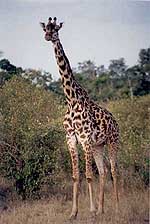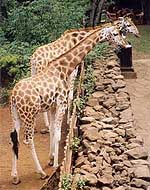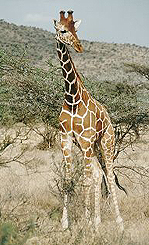GIRAFFE (Masai, Rothschild's, or Reticulated)



How to Recognize
Giraffes are very common to see. They are immensely tall (up to 17 feet) with long necks, legs, and tails. Both sexes have knob-like horns on their tapered heads and 18-inch long tongues. Males have bald tipped horns while females have hairy horns.
Their necks are the longest in the animal kingdom and only have seven bones (the same as humans and every other mammal). To prevent fainting when it bends down to take a drink, their arteries have special valves that stop the blood from rushing down to the head.
There are three types of giraffes in East Africa, and we saw two of them. The Masai giraffe has large leaf-like markings on its body. The Rothschild’s giraffe is paler in color (somewhat yellow) and has white “socks.” The Reticulated giraffe have fine white lines separating large reddish patches and are found in northern Kenya (we didn't go there).
Habitat
Giraffes can be found in the savannah, open woodland, and thorn country. In the dry season, giraffes can be found along drainage lines on evergreen foliage. They disperse across the plains during the rainy season.
Behavior
Diurnal and partly nocturnal. They never seem to be in a hurry, and when walking both left legs then both right legs move alternately. They live in loose, non-territorial, leaderless herds. These herds can be single-sex or mixed.
To assert dominance, young bulls will jostle and intertwine their necks, delivering blows with their heads. “Necking” thus establishes social hierarchies from an early age and adult males rarely contest seriously at mating time. A swing from a bull’s head can break its opponent’s neck or jaw.
Breeding
Breeding takes place year-around with large bulls monopolizing the mating. Calves are six feet tall when born and join the herd after two weeks. They are weaned after twelve months. Cows calve in the same area year after year.
Feeding
Giraffes browse on trees, mainly acacia leaves, buds, shoots, and fruits. They are the only animals other than elephants which do so. They spend most of their day chewing their cud. They must drink once a week by spreading their front legs and bending down. This makes them vulnerable to predators.
Enemies
Juveniles are prone to predators, and lions will even take down full grown adults. In full flight, a giraffe can outrun any predator.
TOP OF PAGE
Copyright © 2002, Dawn M. Dalton.
All rights reserved.
**LINKS**
WHERE?
WHY?
ITINERARY
PLAN YOUR TRIP
GETTING THERE
LONDON
KENYA
UGANDA
SAFETY
ITEMS BOUGHT
STAYING HEALTHY
COMMENTS
HOME
BHS HOME
---Animal Facts--
Baboon
Buffalo
Cheetah
Chimpanzee
Crocodile
Eland
Elephant
Gazelle
Giant Forest Hog
Giraffe
Gorilla
Hippopotamus
Hyena
Hyrax
Impala
Jackal
Lion
Mongoose
Monkey
Ostrich
Rhinoceros
Topi
Uganda Kob
Warthog
Waterbuck
Wildebeest
Zebra